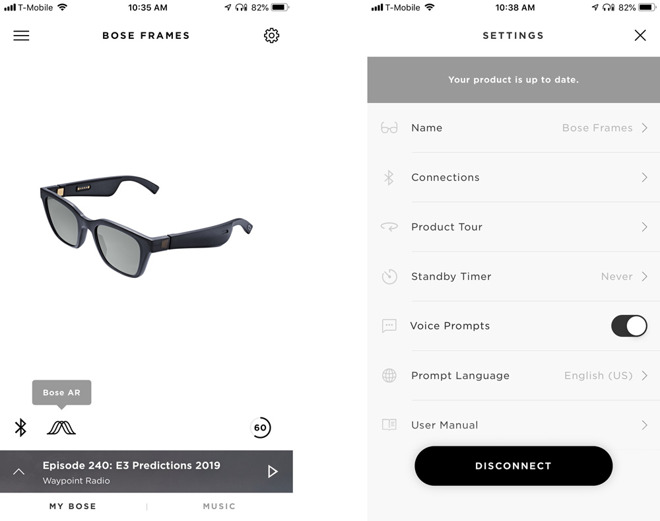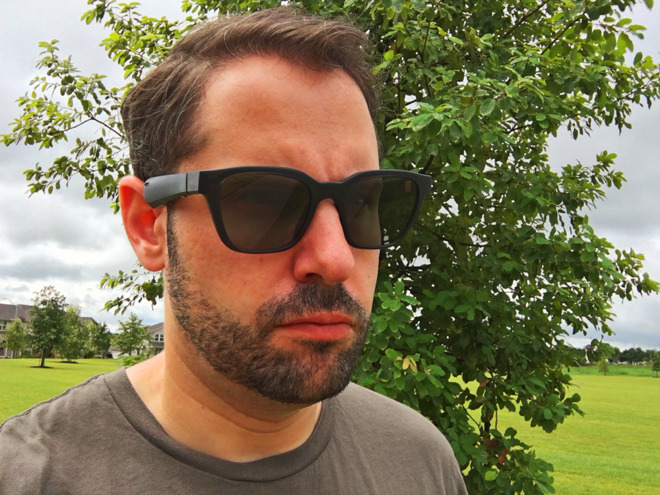Hands on: Bose's speaker-equipped Frames sunglasses for the iPhone
They might seem like a gimmick at first, but Bose's iPhone-compatible Frames sunglasses may be a serious contender if you want portable music without some of the usual downsides.
Like many of you I imagine, when I first heard about the Frames I intially expected them to be a novelty for the rich. I pictured little more than a pair of small Bluetooth speakers jammed into the legs, albeit with Bose quality behind them.
On a simple level that's accurate. Nominally you're supposed to use the Bose Connect app to pair, but in truth they can pair much the same as any Bluetooth device if you don't care about settings or special functions. Small speakers are indeed located in each leg, angled to pump sound into your ear canals.

There's a lot more going on under the surface though, very literally. After unboxing I decided to pop the Frames on while I got going with setup -- to my surprise they immediately went into pairing mode, reflecting the presence of motion sensors. To turn them off, the normal thing to do is flip them upside-down for 2 seconds. You can additionally set a standby timer.
There's far more testing for me to do, especially when riding electric scooters and skateboards, but I was immediately impressed by the Frames' sound. They're startlingly loud and clear, such that you should have no trouble hearing them under most circumstances. One thing slated for my experiments is audio "bleed" -- though based on my limited experience, it seems similar to or better than open-back headphones.
One of the main benefits of the Frames is that they don't obstruct your ears. This means they're inherently more comfortable, and you can still catch conversations and other environmental cues so long as you don't have the volume too high.
Bose sells two styles: the Alto and the Rondo. We tried the Alto, a conventional "square" look. This will probably be the go-to for most people, and I enjoyed it myself, but the Rondo may be more appealing for some people, especially those with smaller heads.
Either style is built to be shatter- and scratch-resistant, and offer 99% UVA/UVB protection. They're not rated against sweat or anything but light rain however, and they're not polarized against reflections either unless you spring for $29.95 mirrored lenses. If you need a prescription, you're out of luck.
I have a few other complaints, such as a lack of onboard volume controls, but we'll cover those in a full review coming soon. As things stand I'm reasonably impressed.
Like many of you I imagine, when I first heard about the Frames I intially expected them to be a novelty for the rich. I pictured little more than a pair of small Bluetooth speakers jammed into the legs, albeit with Bose quality behind them.
On a simple level that's accurate. Nominally you're supposed to use the Bose Connect app to pair, but in truth they can pair much the same as any Bluetooth device if you don't care about settings or special functions. Small speakers are indeed located in each leg, angled to pump sound into your ear canals.

There's a lot more going on under the surface though, very literally. After unboxing I decided to pop the Frames on while I got going with setup -- to my surprise they immediately went into pairing mode, reflecting the presence of motion sensors. To turn them off, the normal thing to do is flip them upside-down for 2 seconds. You can additionally set a standby timer.
There's far more testing for me to do, especially when riding electric scooters and skateboards, but I was immediately impressed by the Frames' sound. They're startlingly loud and clear, such that you should have no trouble hearing them under most circumstances. One thing slated for my experiments is audio "bleed" -- though based on my limited experience, it seems similar to or better than open-back headphones.
One of the main benefits of the Frames is that they don't obstruct your ears. This means they're inherently more comfortable, and you can still catch conversations and other environmental cues so long as you don't have the volume too high.
Bose sells two styles: the Alto and the Rondo. We tried the Alto, a conventional "square" look. This will probably be the go-to for most people, and I enjoyed it myself, but the Rondo may be more appealing for some people, especially those with smaller heads.
Either style is built to be shatter- and scratch-resistant, and offer 99% UVA/UVB protection. They're not rated against sweat or anything but light rain however, and they're not polarized against reflections either unless you spring for $29.95 mirrored lenses. If you need a prescription, you're out of luck.
I have a few other complaints, such as a lack of onboard volume controls, but we'll cover those in a full review coming soon. As things stand I'm reasonably impressed.



Comments
I think the biggest unlock for me is that when I have sunglasses on, I’m usually driving (car audio) or you’re inside where you don’t wear them. The sound quality for calls and the microphone needs improved.
Again, may be good for some but not for me. I’ll take my AirPods and William Painters any day 👍🏼
If anybody wants to post regarding their local laws please show the authority's code section. It's always a waste of time when someone just blurts out something however vague or specific that turns out to be nothing more that something they 'heard or read somewhere' that turns out to be incorrect.
Any quality lab can ground lenses to fit most frames. These should be no exception unless there's some peculiar method of securing the lenses. However there's certainly a risk of the lab damaging the electronics. One method of installing lenses in plastic frames is to heat them in water. It makes popping lenses in and out very easy. That could easily kill the electronics.
This is an example of a typical bullshit 'internet' post. There's no mentions of bone conduction in the AI article. Where did you get that or are you just making crap up.
Pro Tip: 'like using' is not the same as using.
Do you know for a fact Aftershokz holds the patent on bone conduction in eyeglasses, just like Ford holds the patent on four wheels and steering wheels and putting an audio system in a car?
But since bone conduction audio has been mentioned, however erroneously, while I like the idea and look of the Frames, I'd never consider them without bone conduction. I've heard a lot of people's audio blasting ( ! ) from headphones and earbuds. First, it is annoying, exceedingly so. Second, I wonder what their hearing will be like down the road. Permanent damage is accumulative and can seldom be augmented. Hearing aids don't help all kinds of hearing impairment.
But when you're cool, the sun shines on you all the time.
That's pure genius how you worked that out.
But yes, when you're cool, the sun always shines.